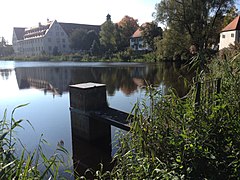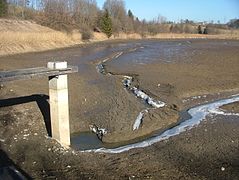Monk (pond farming)
The adjustable drainage structure of a pond is called a monk , through whose drainage it is possible to adjust the water level by means of a pipeline at the level of the pond floor , up to and including complete drainage. At the same time, it acts as a deep water drain . The bottom of the pond is laid out in the form of a shallow funnel with an orientation towards the monk.
The monk itself consists of a hollow body above the drain pipe with dust savers inside which can be used variably depending on the desired height of the water level. On the pond side, the water presses through a recess at the level of the pond floor into the monk, the flow of which can be regulated depending on the height of the dust saver. When the dust saver is dismantled down to the bottom of the pond, the pond water runs into the drainage line without a build-up and the pond thus falls completely dry. The drainage of a pond is necessary for reasons of use and maintenance or maintenance (e.g. fishing, cleaning or desludging ("landing")).
Modern variants have two precisely fitting pipes as the drain pipe. One of the tubes has a helical slot and the other has a vertical slot. Depending on the height at which the helical slot meets the vertical slot, an opening is created there through both pipes, from which the water can drain inwards. The drainage height is adjusted by turning one of the two pipes.
Monk of the
monastery pond forest



